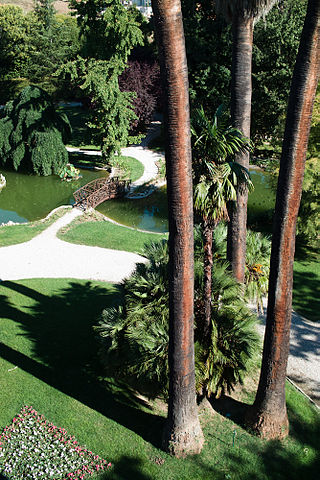
The Province of Imperia is a mountainous and hilly province, in the Liguria region of Italy, situated between France to the north and the west, and the Ligurian Sea, an arm of the Mediterranean Sea to the south. Its capital is the city of Imperia.

Bordighera is a town and comune in the Province of Imperia, Liguria (Italy).

The Giardini Botanici Hanbury, also known as Villa Hanbury, are major botanical gardens operated by the University of Genoa. They are located at Corso Montecarlo 43, Mortola Inferiore, several km west of Ventimiglia, Italy.
The Giardino Botanico Rea is a botanical garden located 450 meters altitude in Val Sangone, at Trana, Province of Turin, Piedmont, northern Italy.

The Orto Botanico dell'Università di Siena is a botanical garden operated by the University of Siena. It is located at Via P. A. Mattioli, 4, Siena, Tuscany, Italy, and open daily.

The Politics of Liguria, Italy takes place in a framework of a presidential representative democracy, whereby the President of Regional Government is the head of government, and of a pluriform multi-party system. Executive power is exercised by the Regional Government. Legislative power is vested in both the government and the Regional Council.

The Johannesburg Botanical Garden is located in the suburb of Emmarentia in Johannesburg, South Africa. The gardens grew out of a large rose garden that was established in 1964 and subsequently expanded from 1969 to cover an area of around 125 hectares (1.25 km2). It is administered by Johannesburg City Parks. The Emmarentia Dam is situated immediately to the east of the garden and shares its extensive acreage. One of the main attractions is the Rose Garden with over 10 000 roses.

Ludwig Winter was a German botanist, nurseryman and landscape designer, creator of gardens such as the Giardini Botanici Hanbury, noted for introducing tall palms and other foreign species to the Ligurian riviera.

The Borgo Storico Seghetti Panichi near Ascoli Piceno in Marche region of central Italy comprises a 13th to 18th-century villa, a 19th-century romantic landscape by Ludwig Winter, a 16th-century chapel to St. Pancras and a farmstead which has been converted into a hotel.

Clarence Bicknell was a British vicar, amateur archaeologist, botanist, artist, Esperantist, author and philanthropist. He founded the Bicknell Museum in Bordighera, Italy. Also named after him is a street in Bordighera, and two plant species.

The Clarence Bicknell Museum is a small concealed building at 39 Via Romana in Bordighera. This is often referred to as its official address, but the large villa is the seat of the International Institute of Ligurian Studies. To the right of the building is via Clarence Bicknell, leading to the entrance of the gardens of the villa and of the museum. The two buildings are part of the same block. In 1888, Clarence Bicknell built the museum to collect, preserve, and exhibit his archaeological and botanical collections.

The Villa Etelinda is a villa of the 19th century located at 38 Via Romana in Bordighera, province of Imperia in Liguria. Originally named Villa Bischoffsheim, the house was renamed in 1896 as Villa Etelinda by Lord Claude Bowes-Lyon, 14th Earl of Strathmore and Kinghorne. The villa is part of the property protected by the Superintendent for Architectural Heritage and Landscape of Liguria.

The Villa Regina Margherita di Savoia is a museum site on the via Romana of Bordighera in Riviera in province of Imperia.

The Villa Mariani is located at 5 Via Fontana Vecchia in Bordighera on the Riviera in the province of Imperia, in northern Italy near the French border.

The Bordighera Town Hall is located at 32 Via XX Settembre in Bordighera, Liguria.

Villa Garnier is a building in Bordighera in western Italy. Villa Garnier and Villa Amica are part of the properties protected by the Superintendent of Ministry of Cultural Heritage and Activities and Tourism (Italy). The villa is located 11 Garnier Street in Bordighera on the Italian Riviera.

The church of the Immaculate Conception, officiated by the Frati Minori Francescani, is at via Vittorio Emanuele 75, in Bordighera, Province of Imperia. The church is also called the Church of the Terrasanta, in honour to the first missionary priests who officiated Mass returning from Palestine. The church is part of the properties protected by the Superintendent of Ministry of Cultural Heritage and Activities and Tourism (Italy).

The church of Sant'Ampelio is located on Cape Sant'Ampelio, at the end of the "Promenade Argentina" in Bordighera in Liguria, Italy. The church is part of the properties protected by the Superintendent of Ministry of Cultural Heritage and Activities and Tourism.

The Moreno Gardens of Bordighera which were described by many tourists in the 19th century, no longer exist. Only a small portion survives as today’s Monet gardens, which are located in Via Domenico Tumiati, and in some private properties. The remainders of the Moreno Gardens and Villa Palmizi are part of the properties protected by the Superintendent of Ministry of Cultural Heritage and Activities and Tourism (Italy).

The Winter Gardens were created by the German botanist Ludwig Winter and they are located at 6, Via Ludovico Winter in Bordighera, Liguria, Italy.






















